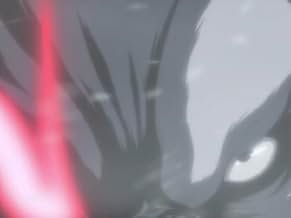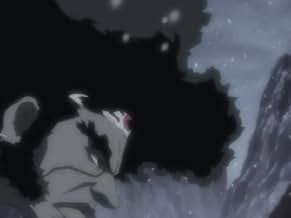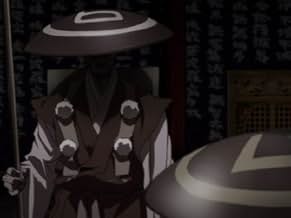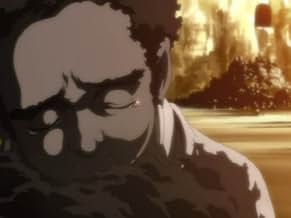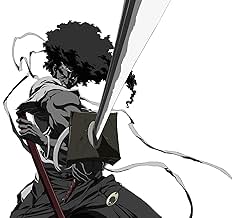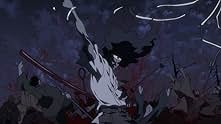Un samurái negro emprende una misión para vengar la muerte injusta de su padre en un Japón feudal futurista.Un samurái negro emprende una misión para vengar la muerte injusta de su padre en un Japón feudal futurista.Un samurái negro emprende una misión para vengar la muerte injusta de su padre en un Japón feudal futurista.
Explorar episodios
Argumento
¿Sabías que...?
- CuriosidadesSamuel L. Jackson and Phil LaMarr appeared in Pulp Fiction (1994).
- Citas
Afro Samurai: Nothing personal. It's just revenge.
- Versiones alternativasThe DVD is available in two versions: a Spike TV edited version and a Uncut/uncensored version with more sex and violence.
- ConexionesFeatured in Anime: Drawing a Revolution (2007)
- Banda sonoraHate
Written by Michael Baiardi and Christian Altman and Matthew Harris
Published by Soundfile Publishing (ASCAP)
Performed by M1
Courtesy of Soundfile Records
Reseña destacada
Afro Samurai came out of left field from me. Totally unexpected, I saw the tile pop up somewhere and sounded cool enough for me to give it a go. And even though I'm not an anime fan, I found lots to appreciate in this mini series of blood and mayhem.
The main appeal for me was the combination of blaxploitation culture and samurai swordfighting (chambara). Samuel Jackson doing the voice-overs for both Afro Samurai (Clint Eastwood style, few words, calm and badass) and his sidekick Ninja Ninja (wisecracking non-stop banter) was another major plus. The third advantage is the simple story that takes its cue from a long line of revenge movies: this is a simple revenge story and that's why it works so well.
In a futuristic world, young kid watches his father get cut down by baddie who is after his father's Headband #1. Headband #1 allows its bearer to be like a god. The only one who can challenge him is the one who wears Headband #2. Anyone can challenge Headband #2. As one could expect, Headband #2's path is littered with corpses as everyone and their dog want their chance to challenge Headband #1. Young kid grows up and becomes Afro Samurai and walks the path of revenge against Headband #1. A colourful ensemble of baddies will stand in his way, from a neo-Buddhist cult of assassin monks, to cyborgs to teddy-bear faced guys with a grudge to common crooks. Through flashbacks we come to find out how Afro Samurai became who he is and how he obtained Headband #2. Simple yet effective.
The main appeal here is the visual aspect. Being a fan of 60's and 70's chambaras and jidai-gekis I find the swordfights a tad too hyperkinetic for my taste, but that's anime for you I guess. However everything has a smoother, more westernized approach perhaps to the rapid, eyesore that often is the genre which I took to with pleasant surprise and relief. The graphics and design tend to be great (especially Afro Samurai's) although they can settle for just good or serviceable at times. The blood geysers and slashing, taking their cue from stuff like Lone Wolf and Cub and Lady Snowblood (copious amounts of glorious arterial sprayings) will please every fan of the red stuff although it's not particularly gruesome. Good, clean, family fun.
The soundtrack is done by usual suspect RZA. I have to say that the whole combo of hip-hop/anime/exploitation works particularly well even though I'm only a fan of the latter third. If you wanna get a picture of what Afro Samurai is, think of the animated sequence in Kill Bill vol. 1.
The main appeal for me was the combination of blaxploitation culture and samurai swordfighting (chambara). Samuel Jackson doing the voice-overs for both Afro Samurai (Clint Eastwood style, few words, calm and badass) and his sidekick Ninja Ninja (wisecracking non-stop banter) was another major plus. The third advantage is the simple story that takes its cue from a long line of revenge movies: this is a simple revenge story and that's why it works so well.
In a futuristic world, young kid watches his father get cut down by baddie who is after his father's Headband #1. Headband #1 allows its bearer to be like a god. The only one who can challenge him is the one who wears Headband #2. Anyone can challenge Headband #2. As one could expect, Headband #2's path is littered with corpses as everyone and their dog want their chance to challenge Headband #1. Young kid grows up and becomes Afro Samurai and walks the path of revenge against Headband #1. A colourful ensemble of baddies will stand in his way, from a neo-Buddhist cult of assassin monks, to cyborgs to teddy-bear faced guys with a grudge to common crooks. Through flashbacks we come to find out how Afro Samurai became who he is and how he obtained Headband #2. Simple yet effective.
The main appeal here is the visual aspect. Being a fan of 60's and 70's chambaras and jidai-gekis I find the swordfights a tad too hyperkinetic for my taste, but that's anime for you I guess. However everything has a smoother, more westernized approach perhaps to the rapid, eyesore that often is the genre which I took to with pleasant surprise and relief. The graphics and design tend to be great (especially Afro Samurai's) although they can settle for just good or serviceable at times. The blood geysers and slashing, taking their cue from stuff like Lone Wolf and Cub and Lady Snowblood (copious amounts of glorious arterial sprayings) will please every fan of the red stuff although it's not particularly gruesome. Good, clean, family fun.
The soundtrack is done by usual suspect RZA. I have to say that the whole combo of hip-hop/anime/exploitation works particularly well even though I'm only a fan of the latter third. If you wanna get a picture of what Afro Samurai is, think of the animated sequence in Kill Bill vol. 1.
- chaos-rampant
- 11 abr 2008
- Enlace permanente
Selecciones populares
Inicia sesión para calificar y añadir a tu lista para recibir recomendaciones personalizadas
Detalles
Contribuir a esta página
Sugerir un cambio o añadir el contenido que falta

Principal laguna de datos
What is the Brazilian Portuguese language plot outline for Afro Samurai (2007)?
Responde






